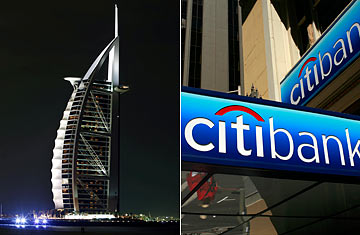
Clarification Appended: Dec. 17, 2009
Perhaps Citi should have slept on Dubai. A year and a half ago, Citigroup became the first U.S. bank to relocate one of its rising stars, Alberto Verme, an investment banking executive, to the booming gulf state. At the time, Citi CEO Vikram Pandit said the move was a sign that the bank was "convinced of the region's long-term and immense growth opportunities."
It may have been a much shorter growth opportunity than Pandit and Citi thought. A few months ago, Verme was reassigned to London (though he has been promoted to ceo of all Citi's business lines across Europe, the Middle East and Africa, and Citi stresses he is "one of its highest ranking executives globally"). Mohammed al-Shroogi, who headed Citi's United Arab Emirates operations, left in September. In late November, Dubai World, which is a for-profit development company controlled by the ruling family of the gulf state, indicated that it may have to default on a portion of its $60 billion in loans. The rush to Dubai has left Citi on the hook for billions of dollars of losses in the financially troubled gulf state. According to research firm Creditsights, Citi has made an estimated $5.9 billion in loans in the U.A.E., which includes Dubai as well as its oil-rich neighbor Abu Dhabi. Of that, $1.9 billion was made to Dubai World. In the end, it might not lose that much. On Monday, Abu Dhabi said it would provide $10 billion in financing to help Dubai pay off its debts. And Citi says that "although we do not comment on individual exposures, we are very comfortable with our investment across all of the UAE, which remains one of our priority markets."
To be sure, Citi's potential losses in Dubai are not enough to bring down the bank. Citi has $2 trillion in assets. And the Dubai losses look puny compared to huge hits the bank took in subprime lending and the mortgage market in general. But Citi was far more aggressive in courting Dubai business and left itself open to far more losses in what now seems was a financial house of cards than any other U.S. bank. JPMorgan, the U.S. bank with the next highest loan exposure to Dubai, has $2.5 billion in loans outstanding in the U.A.E., according to Creditsights, less than half of what Citi may have to write off.
What's more, Citi's bid to expand in the Middle East at a time when the U.S. and the rest of the world was entering a financial crisis appears to be yet another management blunder for what was once the world's largest bank. It's also likely a black eye for Citi as it tries to convince the U.S. government that is wealthy and wise enough to pay back its government support. And unlike the mortgage mistakes, which can be blamed on past management, the rush to profits in Dubai happened under CEO Pandit.
"Obviously, this is not a positive for Pandit," says Michael Holland, a money manager and the former chairman of Salomon Brothers Asset Management, which was acquired by Citigroup. "Being big everywhere is the business model he has chosen. That means when there are losses anywhere you are going to get hit." Things were booming there back in 2008 when Citi sent Verme to the gulf state — from 2004 through 2008 Citi's revenues from the region grew at a 30% average annual rate. He had run the bank's Latin American operations before being promoted to co-head of investment banking. In 2006, trade publication the Banker named Verme one of the top 10 movers and shakers in the Latin American business. It was big news in banking circles when Citi tapped Verme for Dubai.
Massive building projects funded by debt offerings was driving Dubai's economy, creating lot of opportunities for bankers. Many other banks followed Citi's lead. Citi reportedly built up a staff of 50 bankers in the area. But as things started to unravel Citi remained deeply invested in Dubai. In late 2008, just weeks after Citi had received its initial TARP funding from the government, Citi helped arrange an $8 billion loan for Dubai's state-linked companies. It's unclear how much of the loan Citi held onto. By that time, Citi's own research staff had begun to issue warnings that Dubai was the most vulnerable economy in the oil-rich gulf because of its exposure to real estate and debt. Nonetheless, Win Bischoff, who was Citi's chairman, said at the time of the financing, "This is in line with our commitment to the [U.A.E.] in general, and reflects our positive outlook on Dubai in general."
These days it is clear that Citi's outlook was much more positive than it should have been. If that's the case in other areas of the world, Citi could be looking at more losses down the road.
The original version of this story has been updated to reflect Citi's contention that Verme's job change was not a demotion, but a promotion, that Dubai was not a 'financial house of cards,' and that the bank is 'comfortable with [its] investment across all of the UAE.' When TIME originally asked about its operations in Dubai, Citi declined to discuss the situation in detail, or for publication.
